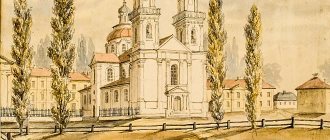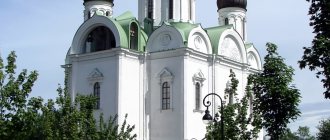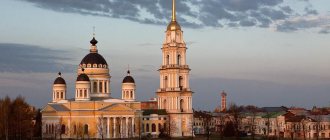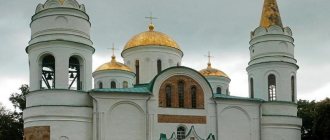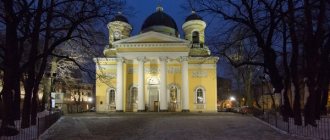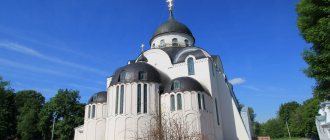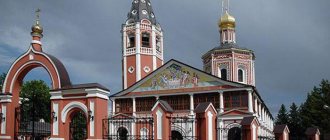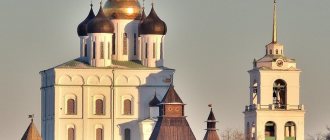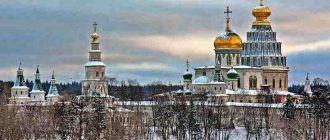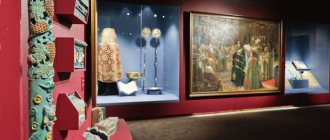Romanov-Borisoglebsk (now Tutaev) is an ancient city in the Yaroslavl region, which stretches on both sides of the Volga. Borisoglebsk (the first mention of it dates back to 1238) is the right-bank part, which is considered more ancient than Romanov, located on the left side of the river.
The most famous architectural monument of Borisoglebsk is the Resurrection Cathedral - one of the most majestic in the Yaroslavl region.
History of the temple
Almost no information about the early history of the temple has been preserved. The chronicles tell that even during the Tatar-Mongol invasion, monks came to these places, who erected a wooden temple in the settlement in honor of the princes - Saints Boris and Gleb. Presumably this happened in 1238.
Nothing more is known for certain about the fate of the temple, but now in the place where the church altar was located, on the north side of the cathedral there is a memorial pillar with a cross. In 1652, the city residents, on the site where the wooden church stood, erected a stone cathedral in honor of the icon of the Smolensk Mother of God, also called “Hodegetria.”
The illumination of the church took place on June 24, 1652. However, errors were made during construction, which resulted in the partial destruction of the building.
In this regard, the residents of Borisoglebsk turned to Jonah Sysoevich (Metropolitan of Rostov and Yaroslavl) with a request to give permission to build a new two-tier church, especially since there was already a large donor in the person of the merchant Kotlovanov, who helped not only with money, but also with deeds (the place of his burial located on the temple grounds).
In 1670, on the still strong walls of the Theotokos Church, construction began on the cathedral in honor of the Resurrection of Christ, which was built and illuminated in 1675.
Resurrection Cathedral of Tutaev, Yaroslavl region
During the Soviet period, the cathedral was not closed; it preserved its shrines and decorations, and the unique wall painting was preserved. During the entire period of its existence, the cathedral never stopped its prayer service for a single day. On the contrary, in the 20th century. there was a fairly large community here (in 1945 there were more than 1000 people).
At one time, Saint Righteous John of Kronstadt, Saint Tikhon Belavin, the future Patriarch of Moscow and All Rus', prayed in the cathedral.
Now the cathedral has a library and a museum; exhibitions are constantly organized, theological courses are held, and various social work is carried out. There is a pilgrimage service whose workers organize trips to places of pilgrimage.
Architecture, appearance
Tutaev's Resurrection Cathedral, designed by an unknown author, was built in the style of Russian patterns (Russian Baroque). It is magnificent not only during the day, but also at night. In 2006, artistic lighting of the building was made, consisting of 280 lamps.
Now its architectural ensemble consists of:
- the building of the temple itself (length 35 m, width 30 m, height 49.7 m);
- hipped bell tower (built in the 2nd half of the 17th century);
- a little later (at the end of the 17th century) a low stone fence and the Holy Gate were completed;
- a memorial sign installed on the site of an old wooden church (located outside the territory of the cathedral);
- gatehouse (1910).
Tent bell tower
Note. The bell tower (and the Holy Gate) are located on the south side of the temple. It has a slight slope, so on the opposite side there is an extension that prevents further tilt.
Until the 19th century. in the bell tower there were ancient bells and a large striking tower clock made by famous watchmakers. Currently, city residents really hope that this unique mechanism will be repaired and the clock will begin to count time again.
Construction of the Resurrection Cathedral lasted until 1678. The exterior decoration of the temple consists of unique church paintings and a striking ornate brick pattern on the walls. At the same time, the southern façade of the building, facing the main street of the city, is decorated in a particularly festive manner.
The stone fence, which is considered a full-fledged part of the architectural complex, appeared only in 1856 thanks to the efforts of the merchant Stepan Shchukin.
2-tier galleries surround the cathedral on 3 sides. The temple is decorated with paintings by Yaroslavl and Kostroma masters. The wall frescoes were completed in 1679. The design work was probably carried out under the direction of Dmitry Grigoriev (Plekhanov).
Authorship is presumably determined by experts in iconography and style. The porches were painted with the participation of the Karpov brothers - Ivan and Fyodor (famous Yaroslavl icon painters) in 1680.
The temple itself is two-tiered, with 4 pillars inside and a vault topped with five domes. The first floor is winter (heated), the top floor is summer (cold). To ascend to the upper temple, 2 porches were built - southern and western.
Architectural sights of the city
The architecture of Tutaev also deserves close attention from visitors - there are many famous buildings to visit that have become symbols of the city.
Fire Tower
- Address: st. Lenina, 59/8.
The former fire tower is a 4-story building with a small superstructure, which resembles a truncated pyramid in shape. It is located in the historical part of Tutaev - on Bazarnaya Square.
Today there is an observation deck on it. Any tourist has the opportunity to view the city panorama from a height of about 25 m. And thanks to night illumination, starting from July 2022, it is possible to take photos here even in the dark.
House of the merchant Vagina
- Address: st. Lunacharskogo, 38.
Vagin's house is considered today an example of Tutaev's estates built in the 19th century. Here, visitors can easily view the exhibition, which reconstructs the living rooms of the merchant houses of that time, including the dining room, living room and bedroom, thus briefly plunging into the atmosphere of that period.
In addition, on the perimeter of the attraction there is also a copy of a merchant’s shop, where copies of goods typical of that time are presented, including Riga balsam and an assortment of iron and hardware goods. Money from that period and steelyards are also on display here.
Wooden dacha of merchant Sorokin
- Address: Left Bank rural settlement.
The dacha of the merchant Sorokin is currently only ruins that have come down to us from a beautiful house that once stood on this territory, built entirely of wood. It is still possible to see wooden carvings and many ornaments on them. The dacha is geographically located in Krasny Bor, in the vicinity of Tutaev.
Back in 1868, there was a magnificent park around the building with numerous fountains, gazebos and a pond with a grotto. But after the revolution in October 1917, it was given over to a rest home, and after some time to a camp for children. Since the 90s, its territory has been empty. Nowadays it is almost completely destroyed and to restore it will require a lot of restoration work.
House of notary V.F. Masloka
- Address: Kazanskaya st., 4.
Located on the eastern bank of the Volga, the house is extremely beautiful and interesting, especially for those who like to take memorable photos. Vasily Fedorovich Maslok is a well-known notary in the Tver region who lived in Tutaev. By the way, the estate still belongs to the Maslok family.
The mansion was built in 1892. It is made of local Romanov brick, which has a beautiful red-brown tint. The striking decorations of the Masloka estate are an oblong balcony, more like a terrace, and a veranda. The highlights of the structure are the whitish half-columns and carved window casings.
Stroganov barn of Yuri Starodubov
- Address: Lenin Square, 6A.
This architectural monument is also located in Romanovo, which is now in a deplorable state, but enthusiasts are engaged in its restoration. The Stroganov salt warehouses in Tutaev were built at the end of the 17th – beginning of the 18th centuries. For a long period, the barn was abandoned, gradually, over time, collapsing and becoming unusable. Today there is hope for the restoration of the complex.
Interior decoration
The decoration of the cathedral took many centuries to develop. Despite the fact that each period made its contribution, the temple is distinguished by its indescribable harmonious beauty.
Summer Temple
The summer temple surpasses the winter one in its splendor, since its walls are completely covered with frescoes, which are regularly restored and maintained in proper condition. The exterior paintings are also authentic, created at the end of the 17th century. Their safety is also ensured by ongoing restoration work.
Many paintings are provided with commentaries, including biblical quotes and poems by Simeon of Polotsk, a spiritual writer and theologian.
In the summer temple there are thrones:
- Resurrection of Christ (main);
- Nicholas of Myra, as well as Peter and Paul;
- Boris and Gleb (in the deacon).
The 8-tier iconostasis of the upper church is made up of icons that experts attribute to the 17th–18th centuries. This includes images belonging to the more ancient tyablo iconostasis, dating from the end of the 17th century. The iconostasis is crowned with a Crucifix, complemented by the upcoming Mother of God and John the Theologian. The main carved detail is a grape vine, symbolizing the teachings of Christ.
The central tier of the southern and northern walls are painted with Gospel scenes, the western wall introduces paintings depicting the events of the “Last Judgment”. In addition to biblical ones, wall paintings include scenes that serve as illustrations for works of art that commemorate certain historical events (for example, the Baptism of Rus').
On the vaults in the drawings the content of the First Book of Moses unfolds sequentially. Also on the vaults of the southern gallery you can read the whole story in pictures from the creation of man to the fall of our ancestors.
Particularly revered relics are located in the northeastern part of the upper temple.
Winter Temple
It is dedicated to the icon of the Blessed Virgin Mary. On the right side of the entrance there is a wall chronicle telling about the consecration of the church in 1652.
The thrones are set here:
- Smolensk Icon of the Mother of God;
- Charalampia of Magnesia (southern limit);
- John the Baptist (northern limit).
The lower temple is decorated with a 1-tier iconostasis, above which on the wall you can see the Deesis rite. The iconostasis includes images painted in different periods of time.
Used materials
- “About the temple”, page of the official website of the cathedral:
- Brief information about the monasteries and churches of the Yaroslavl diocese. - Yaroslavl, 1908, p. 440-441.
- Historical information on the official website of the Yaroslavl diocese.
[1] According to other sources, the upper temple was erected in 1672 and consecrated in memory of the Renewal of the Church of the Resurrection of Christ in Jerusalem.
[2] Brief information about the monasteries and churches of the Yaroslavl diocese. - Yaroslavl, 1908, p. 441.
[3] Historical information on the official website of the cathedral -
Shrines
The cathedral preserves not only its own, but also Christian relics of other churches. Many icons and church utensils are collected here. Now you can find in it shrines older than the Resurrection Cathedral itself, since after its construction small and old churches were closed or destroyed, and all their relics eventually ended up in the cathedral.
Icon "The All-Merciful Savior"
The main relic of the cathedral is a huge image of the Savior with dimensions of 2 m 98 cm by 2 m 79 cm (some sources indicate dimensions of 3.2 by 2.8 m). The icon is older than the cathedral itself and dates back to the 15th century. Over the course of several centuries, the image became very dark, since in ancient times, for better preservation, icons were covered with sunflower oil, which acquired a darker color over time.
It is believed that the icon of the Savior belongs to the brush of Dionysius Glushitsky (although this information may be inaccurate).
The icon was very loved, especially by the Old Believers, of whom there were many in Borisoglebsk at that time. In the mid-18th century, Arseny Matveevich (Saint of Rostov) took the icon to Rostov, which was one of the ways to fight the Old Believers, who greatly revered this icon.
For more than 40 years, the people of Borisoglebsk begged for the icon to be returned to the Ascension Cathedral. When permission to return the shrine was received, believers carried the icon in their arms from Rostov to Borisoglebsk (in a straight line this is about 500 km). Three miles from the city, the procession was stopped to wash the image from road dust in the Forge River.
In the Resurrection Cathedral, the shrine is placed in a special icon case and a holiday is established on September 18 in honor of its return. In memory of this event, a silver-gilded crown of precious and semi-precious stones was placed on the icon, and in the mid-19th century. - silver and gilded chasuble.
In 1921, the decoration of the icon was removed under the pretext of raising funds for the benefit of the starving people of the Volga region. But in this same very difficult year, residents of Borisoglebsk and Romanov are collecting funds bit by bit for a new, more modest crown (the current one is a copy of the lost one).
In honor of the return of the shrine, 2 religious processions are held every year: large and small. On the 10th Sunday after Easter, a small religious procession is held, which covers only the right bank.
The second godfather passes along the left Romanov bank on the last Sunday before the feast of Elijah the Prophet, which is celebrated on the 2nd.
The icon is carefully carried through Borisoglebsk in their arms to the ferry, which transports it to the left side of the Volga, where it is brought to every church on the Romanov side of the city of Tutaev. Therefore, the religious procession on the left bank is larger and lasts much longer than on the right bank.
In addition, the icon is moved 2 more times a year: in the spring it is moved to the upper church, and in the fall (before the Intercessions) - to the lower (heated) one.
In honor of the return of the shrine, 2 religious processions are held every year: large and small. On the 10th Sunday after Easter, a small religious procession takes place, which covers only the right side. The second godfather passes on the left bank a little earlier than this time (on the last Sunday before the feast of Elijah the Prophet, which is celebrated on the 2nd).
The icon is carried in their hands to the ferry, which transports it to the left side of the Volga, where it is brought to every temple on the Romanov side of the city of Tutaev. Therefore, the religious procession on the left bank lasts much longer than on the right.
The icon of the Savior was originally painted for a wooden church. It was written “under the sky,” that is, in the old temple the image was located under the very dome.
When the stone temple was built, there was no longer a need to place it “under the sky,” so it was placed a little lower. But when religious processions began to take place, people tried to pass under the icon to receive grace from the Savior.
But there were too many applicants, and not everyone made it in time. Therefore, a special hole (window) was made in the icon case under the icon, which allowed everyone, at any time, to crawl three times on their knees under the icon and ask the Savior for the fulfillment of a desire, healing from physical and spiritual ailments. Over the course of a couple of centuries, a trail similar to 2 ruts formed from the knees of believers.
Cross with Crucifix
The Resurrection Cathedral of Tutaev preserves such a shrine as the cross with the crucifixion of the Lord, which is installed in the icon of the “Passion of Christ” in the summer church.
The relic, dated by specialists from the 15th – 16th centuries, according to legend, floated down the river to the church site.
Smolensk Icon of the Mother of God (“Hodegetria”)
“Hodegetria” (in Greek this means “Guide”) is a copy of the icon with which, according to legend, in 1046 the Byzantine Emperor Constantine IX Monomakh blessed his daughter for marriage with the Kyiv prince Vsevolod Yaroslavich. Subsequently, the image was transported by their son Vladimir Vsevolodovich, nicknamed Monomakh, to the city of Smolensk.
The frame is decorated with a gilded crown and a chasuble embroidered with stones.
Image of Nikolai Mozhaisky
The cathedral contains a wooden sculpture of St. Nicholas the Wonderworker. The wooden sculptural image was created in honor of St. Nicholas, who is the patron saint of the city of Mozhaisk. Initially, the saint held a sword in one hand, and in the palm of his other hand there was an image of Mozhaisk, which was lost over time. Now, instead of a model of the city, Nikolai Mozhaisky holds the Gospel.
The wooden sculpture of St. Nicholas the Wonderworker is dressed in a chasuble and slippers embroidered with beads. The saint wears clothes of different colors depending on the holiday. The saint's outfit is completed by a miter embroidered with gold threads.
Icon "The Hieromartyr Charalampios"
The icon was painted in honor of Bishop Harlampius, who lived in Greece in the second century and suffered martyrdom for professing the Christian faith among pagans. It is believed that the image was intended for a warm church and was painted by one of the Yaroslavl icon painters.
Interesting facts and legends
Many shrines of the Resurrection Cathedral are considered miraculous.
- For example, the icon of the “All-Merciful Savior” has darkened over time, but the image of the Savior is clearly visible. But there is a belief that wives who are unfaithful to their husbands do not see him.
- At the place where the icon of the “All-Merciful Savior” was washed during its return from Rostov to Borisoglebsk, a healing spring flowed.
- Healing from physical and spiritual ailments is a miracle that is attributed to holy miraculous images. Thus, in 2008, a case of healing of a child from a heart defect after a prayer addressed to Nicholas of Myra was officially registered.
An association
In 1822, by decree of Emperor Alexander I, Romanov and Borisoglebsk became one city. This was done for economic reasons. After the unification, Romanov-Borisoglebsk was not characterized by rapid development. During the 19th century, no significant stone buildings were built in the city. However, some sectors of the economy flourished: flax manufactory and a mineral oil plant. The breed of sheep bred in the vicinity of the city was known throughout Russia.
How to get there by car, public transport
Tutaev can be reached from Yaroslavl or Rybinsk. These are the nearest large cities, from which you can get to Tutaev by regular buses.
Yaroslavl–Tutaev:
| Distance | Travel time | Bus departure time | Ticket price | |
| first flight | last flight | |||
| 43 km | 1 hour | 5. 20 | 21.30 | From 114 rub. |
Note. You should pay attention to the point of arrival: you need buses that arrive at the right bank part of Tutaev, since there is no direct year-round communication between the parts of the cities (in the summer you can use the ferry services).
Rybinsk–Tutaev (there are direct and transit buses):
| Distance | Travel time | Bus departure time | Ticket price | |
| first flight | last flight | |||
| 49 km | From 40 min. up to 2 hours | 6.00 | 23:00 | From 192 rub. |
Tutaev's Resurrection Cathedral is located 2 km from the city bus station. Regular buses also run from Moscow (from the Shchelkovo bus station) to Tutaev several times a day. Travel time is about 6 hours.
If you need to get to the Resurrection Cathedral by your own transport, you should take the P-151 road. You can leave your car in the parking lot, which is located next to the Resurrection Cathedral.
Tutaev
The original name of the city was Romanov-Borisoglebsk. The decision to rename was made during the Civil War. The current name comes from the name of a Red Army soldier who died during the suppression of the White Guard uprising in Yaroslavl.
The city arose as a result of the merger of two separate settlements - Romanov and Borisoglebsk, located on the left and right banks of the Volga. Until 1822 they were independent administrative units.
Where to stay
Accommodation can be found in close proximity to the Resurrection Cathedral.
Hostel "Volzhskie Prosty"
It is located 513 m from the cathedral (Yaroslavskaya 36a). Living conditions are rated “excellent”.
Accommodation is possible in dormitory rooms (up to 11 people) or double rooms with 2 beds and a bathroom. There are family rooms and non-smoking rooms. The shared kitchen is equipped with everything you need. There are shops, restaurants and cafes nearby the hostel.
There is a tour desk and the assembly hall can be rented. Price for 1 day from 600 rub.
Hotel "Ekaterina"
Located 562 m from the cathedral (Sobornaya 53). Living conditions about. All rooms have air conditioning, upholstered furniture, and the necessary equipment. There is also a shared kitchen, laundry, and sauna.
Cost of living from 2000 rub.
Hotel Imperium
Located at a distance of 1.2 km from the Resurrection Cathedral (Rosa Luxemburg St., 44). The hotel's conditions are rated "good" by residents. All rooms have a private bathroom, air conditioning and TV. Guests can enjoy breakfast at the hotel's restaurant (room delivery is available). There is a sauna, the services of which are paid separately.
Cost of living from 1400 rub.
Recreation center "Ertsog"
The Ertsog recreation center is located 3 km from the city center and 4 km from the Resurrection Cathedral in the village of Fominskoye. It may be of interest to tourists who prefer active recreation. Accommodation options: hostel rooms or camping area. There is a Russian bathhouse with a nearby font.
Suggested entertainment:
- paintball;
- swimming in the Volga in the summer;
- fishing;
- paragliding;
- in winter, skiing and snowboarding;
- ice rink;
- dog sledding.
There is a rental point for the necessary equipment on the territory of the base. The cost of accommodation per day is from 500 rubles.
The Resurrection Cathedral in the city of Tutaev is recognized as one of the best examples of Yaroslavl architecture in its heyday. Its interior contains works of ancient Russian icon painting and wooden sculpture of high artistic merit. Therefore, the Resurrection Cathedral is classified as an architectural monument and is subject to protection as a national treasure.
Author Irina Zhuravka
The most interesting monuments of Tutaev
Through monuments, steles and memorials, like nothing else, the history of each city or village is shown. Tutaev is no exception; his monuments are worth taking memorable photos against their background.
Monument to Tolbukhin
- Address: Yubileinaya Square.
The marshal's birthplace is Romanovo-Borisoglebsky district. Here he was born in 1894. For his great services during the Great Patriotic War, he was awarded the Order of the Red Banner, Lenin and some others.
His bust is a decoration of Tutaev’s Jubilee Square. For many years now, ceremonial events with laying of flowers have been held near it. People often come here to honor the memory of all Soviet soldiers.
Lenin monument
- Address: Lenin Square.
The opening of the monument to Lenin in Tutaev was timed to coincide with the 40th anniversary of the October Revolution. The place for it was initially determined on the square of the same name, which was previously called Spasskaya.
Now this place is one of the busiest in Tutaev. It often becomes a location for various folk festivals, including the annual festival dedicated to the Romanov sheep.
